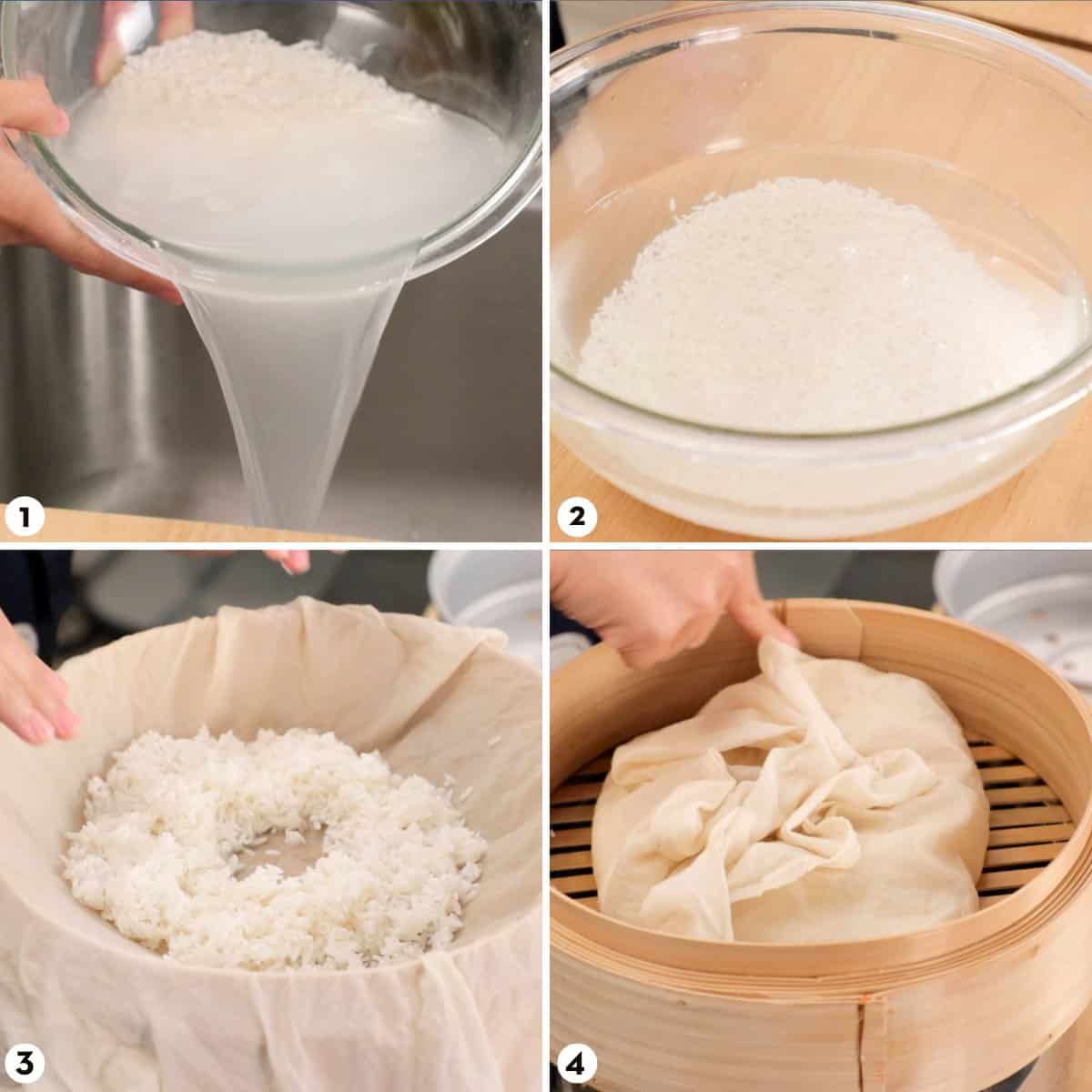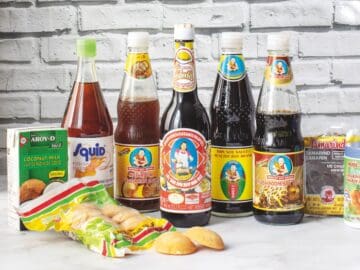Rice is an absolute foundation of Thai cuisine, and while jasmine rice is Thailand’s staple and is the most widely consumed, sticky rice is also very popular, especially in the north and northeast of Thailand, where it is arguably the default rice.
There is a lot of confusion about sticky rice because it’s not quite as well know, and it requires a different cooking method. In this article, I hope to clarify everything for you!

Want to save this recipe?
What's Covered?
Jump to:
- Video: Sticky Rice 101
- What is Thai Sticky Rice or Glutinous Rice?
- Appearance
- Buying The Right Sticky Rice for Thai Cooking
- Warning: It's Higher in Calories!
- Myth: Glutinous Rice Contains Gluten.
- How to Cook Sticky Rice
- Traditional Bamboo Cone Steamer
- Hack: If You Need to Serve Sticky Rice At Room Temp…
- What to serve sticky rice with
- Storing Leftover Sticky Rice
Video: Sticky Rice 101
If you prefer to watch, you absolutely can! This video covers most of the information in this post!
What is Thai Sticky Rice or Glutinous Rice?
In Thai, sticky rice is what we call khao niew, which literally means chewy rice or sticky rice. If you pick it up with your hand, you’d notice right away that the grains hold on very tightly to each other. And if you eat it, the chew is undeniable - it is dense, and incredibly satisfying.
Though sticky rice is the most common name, it is actually technically called glutinous rice. This disambiguation is important because many people also refer to sushi rice as sticky rice because it is also pretty sticky! But true sticky rice, or glutinous rice, is much sticker and chewier than sushi rice.
Appearance

If you put raw glutinous rice beside non-glutinous rice, you can clearly see that non-glutinous rice is a translucent, while glutinous rice is completely opaque and has a brighter white. This is true of both long grain sticky rice such as the Thai khao niew, as well as short grain sticky rice like the Japanese mochi goma. So I can have the two types of rice sitting side by side in unlabeled containers, and I’d never confuse the two.
Buying The Right Sticky Rice for Thai Cooking

There are many kinds of sticky rice on the market, so to make sure you are buying Thai sticky rice or khao niew, you have to pay attention to the packaging.
First it should say either “glutinous rice” or “sweet rice” on the bag. I’ve never seen it labelled as “sticky rice” but I suppose that is also possible. But to clarify, though it is often labelled as sweet rice, it is not any sweeter than any other kinds of rice. I'm not entirely sure why they use “sweet” here but it is possible that it is because it’s the rice we use for desserts (mango and sticky rice, for example).
And the second most important thing is to check that it's a product of Thailand. If it ticks these two boxes, you’re probably good to go. But it is always safe to check the appearance, making sure it is long grain and opaque white as mentioned above.
Warning: It's Higher in Calories!
Cup per cup, sticky rice is actually higher in calories than jasmine rice, simply because it's so much denser and has lower water content. So if you were to pack a measuring cup full of sticky rice, it would weight a lot more than a cup of jasmine rice.
This difference will also become obvious when you cook it. Sticky rice absorbs much less water and won’t expand nearly as much as any non-glutinous rice.
I like to point this out because it’s easy to overeat sticky rice! It’s so satisfying and it’s so easy to keep going, and next thing you know you’re rolling out of your dining chair. In Thailand, we joke that sticky rice makes you sleepy, but this is because when you eat a sticky rice-based meal you’re usually so stuffed by the end!
This is why it is a popular rice amongst farmers in Thailand who do labour intensive work and need a lot of calories to get them through the day.
Myth: Glutinous Rice Contains Gluten.
Wrong! Many people think that glutinous rice contains gluten because of...well...the name! This is a common misconception, but no, and there’s actually NO type of rice that contains gluten. The word "glutinous" actually refers to the sticky and chewy texture of this rice.
How to Cook Sticky Rice
This can be a bit tricky for first timers as it doesn’t cook in the same way as regular rice. It can absorb very little water compared to non-sticky rice (which is why it’s so dense) and this means that it can overcook very easily if you added even a little tiny bit too much water.
So we don't typically cook it in water (though it is possible). Instead, we soak the rice, allowing it to absorb as much water as it can, and then steam it out of water. The heat of the steam will heat up the water that’s already inside the rice. This way, you ensure that the rice cannot be mushy.
So below I will outline the steps for cooking sticky rice the traditional way. There are other ways to cook sticky rice, some of which may suit your situation better, and you can learn about it in my 7 ways to cook sticky rice post.
How to Cook Thai Sticky Rice Traditionally

- Wash the sticky rice by swishing it around in plenty of water, pouring off the cloudy water, then repeat a few more times until the water runs mostly clear.
- Soak the sticky rice in room temp water for at least 4 hours and up to overnight.
- Drain the sticky rice well, then place it in a steamer rack lined with a moist muslin or tea towel. Make a hole in the center of the rice to help the rice cook more quickly and evenly.
- Fold the edges of the cloth up and over the rice, and then steam it over rapidly boiling water for 25-30 minutes. Serve while still warm!
Traditional Bamboo Cone Steamer

We can't talk about Thai sticky rice without talking about the traditional tool for steaming sticky rice. This bamboo cone steamer is what we call huad and it has been designed specifically for making sticky rice.
The concept is the same as any other steamer, but with the huad's tightly woven basket, you do not need to line the basket with a muslin, and it also allows you to cook a pretty large amount of rice.
Two things you need to know is that you need to soak the basket for at least 10 minutes before cooking otherwise the rice will stick. And 2, you need to flip the rice half way through so it cooks evenly, and you do this by tossing it until it flips.
Hack: If You Need to Serve Sticky Rice At Room Temp…
One problem with sticky rice cooked traditionally is that it becomes dry and firm after it has cooled down. So it’s a bit of a problem if you need to serve the sticky rice at room temperature. But there are a couple of easy hacks:
After the rice has soaked, drain it, and then let it steep in hot off the boil water for 10 minutes. Immediately drain it after 10 minutes, then steam it as per usual. The hot water steep forces the rice to absorb a little more water than it can at room temp.
There is also another method that solves this problem and saves you time, but it requires a little more explanation, so check out my post on hot-soak sticky rice cooking method here.
What to serve sticky rice with
Because sticky rice is so dense, it doesn’t really soak up sauces, so we don't serve it with saucy things like curries or stir fries. But we love eating sticky with meat: barbecued pork skewers, fried chicken, crispy pork belly, you name it. If it’s a hunk of meat, we eat it with sticky rice because the denseness of the rice holds up well to meats.
We also eat sticky rice with northern and northeastern Thai food such as green papaya salad, laab isaan, and northern laab. We also eat it with northern and northeastern dips and relishes, and you’d ball up the sticky rice and dip it like you would a chunk of bread.
BTW, sticky rice is usually eaten by hand, and the stickiness of the grains makes it easy to pick up a chunk of it at a time. Though if you prefer to use a fork, that’s okay too.
Storing Leftover Sticky Rice
Sticky rice is best consumed fresh, the day it's made. But if you have leftovers, you can refrigerate it but just for one day. In the fridge it dries very quickly, and beyond a day, the texture will not be the same after reheating.
You can freeze sticky rice in portions and it will last longer, and the reheated rice will have a texture almost good as new, but be sure to use a freezer bag and get as much air out of the bag as possible to prevent freezer burn. If you can wrap each portion in foil, it’ll stave off freezer burn for longer. It’ll last about a month before it starts to get freezer burnt, but if you package it well, it can last longer.
To reheat, sprinkle a little water on the rice, cover it with a moist towel or paper towel, then steam or microwave it until it is piping hot. It’s important to reheat it until it is as hot as it was when you cooked it, otherwise it will not regain its soft and chewiness.





Leave a Reply